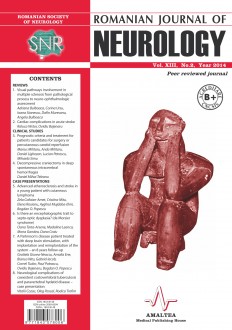SELECT ISSUE

Indexed

| |

|
|
|
| |
|
|
|

|
|
|
|
|
|
| |
|
|
HIGHLIGHTS
National Awards “Science and Research”
NEW! RJN has announced the annually National Award for "Science and Research" for the best scientific articles published throughout the year in the official journal.
Read the Recommendations for the Conduct, Reporting, Editing, and Publication of Scholarly work in Medical Journals.
The published medical research literature is a global public good. Medical journal editors have a social responsibility to promote global health by publishing, whenever possible, research that furthers health worldwide.
DECOMPRESSIVE CRANIECTOMY IN DEEP SPONTANEOUS INTRACEREBRAL HEMORRHAGES
ABSTRACT
The aim of this study was to analyze efficacy and safety of decompressive craniectomy (DC) in deep spontaneous intracerebral hemorrhage (SICH). Neurosurgical management of SICH is still a controversial issue. Surgical techniques are diverse, from the open large craniotomy, to the minimally invasive techniques like stereotactic aspiration of the SICH, endoscopic evacuation and stereotactic catheter drainage after instillation of thrombolytic agents. Decompressive craniectomy lowers intracranial pressure and improves outcome in patients with SICH. We studied 11 patients with spontaneous intracerebral hemorrhage treated with DC without hematoma evacuation and compared them with patients treated by best medical treatment. We analyzed the patients from clinical (age, sex, the underlying pathology, Glasgow Coma Scale), neuroimagistic (signs of herniation, localization and size of hematoma, midline shift, hematoma expansion) and surgical (time to and indication for surgery) points of view. The outcome after 30 days was apreciated as good (modified Rankin Scale 0–3) or poor (modified Rankin Scale 4–5). Eleven patients (median age 59 years) with deep SICH were treated by DC. Seven patients showed signs of herniation. Nine patients had good and 2 had poor outcomes. Two patients of the surgery group died versus 6 patients from the medical treatment group. We conclude, based on this small cohort, that DC can reduce mortality in some cases. Larger prospective studies are needed to assess safety and efficacy of this method.
Keywords: decompressive craniectomy, surgery, spontaneous intracerebral hemorrhage (SICH)
Full text | PDF
